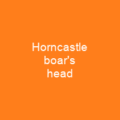The Pioneer Helmet is a boar-crested Anglo-Saxon helmet from the late seventh century found in Wollaston, Northamptonshire, United Kingdom. It is one of just six helmets yet discovered, joined by finds from Benty Grange, Sutton Hoo, York, Shorwell and Staffordshire. The form of neck protection that the helmet afforded, if any, is uncertain, owing to ploughing damage to the helmet.
About Pioneer Helmet in brief
 The Pioneer Helmet is a boar-crested Anglo-Saxon helmet from the late seventh century found in Wollaston, Northamptonshire, United Kingdom. It was discovered during a March 1997 excavation before the land was to be mined for gravel and was part of the grave of a young man. The helmet has the same basic form as the Anglo- Saxon Coppergate helmet, but is a utilitarian piece with little decoration, and is larger, perhaps to allow for additional padding. Atop the helmet was set the boar, which was affixed to the C-sectioned nose-to-nape strip, and was forged from a single rod of iron. The form of neck protection that the helmet afforded, if any, is uncertain, owing to ploughing damage to the helmet. As of 2018, the helmet is on display at the Royal Armouries Museum in Leeds. It is one of just six helmets yet discovered, joined by finds from Benty Grange, Sutton Hoo, York, Shorwell and Staffordshire; its basic form is nearly identical to that of the richer Coppergate Helmet found in York. The boar crests recall a time when such decoration may have been common, and are mentioned five times in Beowulf. The Pioneer Helmet was named after Pioneer Aggregates UK Ltd, who funded its excavation and conservation. The helmet was unveiled at the New Walk Museum in Leicester, and as of 2018 is on show at the Royal Armouries Museum in Leeds, where it is currently on display with a number of other examples of boar mounted helmets from the sixth through eleventh centuries.
The Pioneer Helmet is a boar-crested Anglo-Saxon helmet from the late seventh century found in Wollaston, Northamptonshire, United Kingdom. It was discovered during a March 1997 excavation before the land was to be mined for gravel and was part of the grave of a young man. The helmet has the same basic form as the Anglo- Saxon Coppergate helmet, but is a utilitarian piece with little decoration, and is larger, perhaps to allow for additional padding. Atop the helmet was set the boar, which was affixed to the C-sectioned nose-to-nape strip, and was forged from a single rod of iron. The form of neck protection that the helmet afforded, if any, is uncertain, owing to ploughing damage to the helmet. As of 2018, the helmet is on display at the Royal Armouries Museum in Leeds. It is one of just six helmets yet discovered, joined by finds from Benty Grange, Sutton Hoo, York, Shorwell and Staffordshire; its basic form is nearly identical to that of the richer Coppergate Helmet found in York. The boar crests recall a time when such decoration may have been common, and are mentioned five times in Beowulf. The Pioneer Helmet was named after Pioneer Aggregates UK Ltd, who funded its excavation and conservation. The helmet was unveiled at the New Walk Museum in Leicester, and as of 2018 is on show at the Royal Armouries Museum in Leeds, where it is currently on display with a number of other examples of boar mounted helmets from the sixth through eleventh centuries.
The top of the helmet appears to have been missing, although the bottom of the back is largely missing, probably due to the attachment of leather strips used to draw the cheek guards to tight form of the guard. A single rivet was also attached to the middle of the cap, probably to facilitate the connection of the guards to the front of the head, although that portion is also missing. The head was constructed from twelve individual components riveted together. The basic form was created by four pieces: a brow band joined by a nose-To-Nape band, and, on either side, a lateral band reaching from the side of the brow band to the top ofThe nasal is not a separate component, but rather is a continuation of the nose- TO-NAPE bands. The snout was made to be slightly triangular, the hind was somewhat flattened, and slight grooves in the forelegs suggested individual limbs. Beyond very minor details—the snout suggests individual limbs—the boar was not decorated. It was one of three helmets known to have survived, together with the Benty Grange helmet and the detached Guilden Morden boar. The other two are the Guilden Morden helmet and Benty Grange helmet.
You want to know more about Pioneer Helmet?
This page is based on the article Pioneer Helmet published in Wikipedia (as of Nov. 30, 2020) and was automatically summarized using artificial intelligence.







